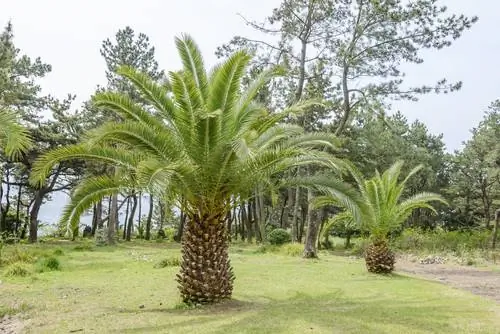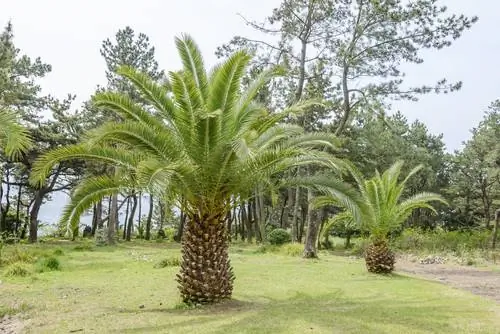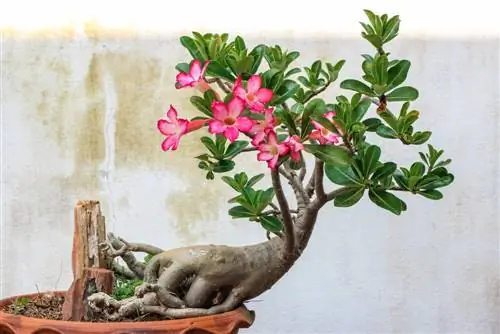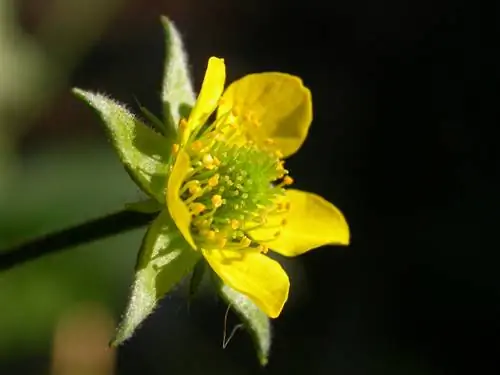- Author admin [email protected].
- Public 2023-12-25 17:45.
- Last modified 2025-06-01 06:02.
The phoenix palm (bot. Phoenix canariensis), also known as the “Canary Island date palm”, can often be found on terraces or in gardens in this country. No wonder, because the attractive plant is considered robust and extremely frugal, which is why it still thrives in the Central European climate. There are around 14 different types of date palms, all of which come from rather dry climates and can be cultivated as ornamental plants in containers.

How do I properly care for a phoenix palm?
The Phoenix palm (Phoenix canariensis) is an attractive and robust potted plant that thrives on terraces or in gardens in Central Europe. It needs a bright, warm location, loose palm soil, regular watering and fertilization as well as a cool winter place with temperatures between 10 and 15 degrees Celsius.
Origin and distribution
The Canary Islands date palm or phoenix palm (bot. Phoenix canariensis) belongs to the palm family (bot. Arecaceae). It is one of around 14 different species of the phoenix palm genus, which, originally from the Near East, have spread across India and North Africa to the subtropical and tropical regions of Africa as well as to the Mediterranean islands, the Azores and the Canary Islands. The phoenix palm, in turn, comes from the Canary Islands, where it is rarely found in the wild. The species is closely related to the real date palm (bot. Phoenix dactylifera), which has been cultivated for its fruits for thousands of years.
Usage
Due to its high ornamental value and robustness, the phoenix palm is often cultivated in this country as a potted plant in gardens, on terraces or balconies as well as in winter gardens. Since the plant is not hardy in our area, it should not be planted in the garden. In the Mediterranean regions, however, it is often found planted in avenues or parks. Date palms develop deep roots that allow them to survive even in very dry environments. For this reason, the plants also thrive in oases in the middle of sandy deserts that are otherwise hostile to life.
If space is limited, we recommend cultivating a dwarf date palm (bot. Phoenix roebelenii), which is ideally adapted to being kept in a container
Use as a houseplant
Even though date palms are often touted as houseplants, you should not keep them in the living room all year round - they only feel comfortable here during the short transitional periods in spring and autumn. During the summer months, however, the Mediterranean plants require significantly more light than they would receive even in the brightest place in the apartment. For this reason, they are better off outdoors. During the winter months, however, it makes sense to spend the winter in a cool, but frost-free and bright place. Phoenix palms that are kept purely as houseplants are generally not expected to have a long lifespan.
Appearance and growth
All date palms are so-called feather palms, which are green all year round and also develop trunks of varying strength depending on the species. The phoenix palm, for example, initially grows without a trunk, as this only develops over the years. In its natural habitat, the Canary Island date palm reaches heights of up to 15 meters, but remains significantly lower when grown in pots. The strikingly patterned trunk of this type of palm develops from the woody stigmas of the dead leaves, with the lower part of older specimens ultimately being smooth. The dwarf palm, in turn, develops a trunk that is only up to 15 centimeters thick and reaches a maximum height of around two meters.
leaves
The characteristic, odd-pinnate leaves of the phoenix palm are located at the upper end of the trunk and protrude in an arched shape. As a rule, the fronds at the tips of the leaves are the same distance apart, which is why the plant always looks evenly grown. Date palms continually develop new leaves while the old ones die off and the trunk gradually forms.
The Canary Islands date palm forms long, tapered, wide fronds up to five meters long with green leaves that can develop into an impressive crown. The dwarf date palm, on the other hand, has fronds no more than two meters long. The petioles of both species are often thorny.
Flowers
In its native locations, the phoenix palm produces numerous flower panicles up to one and a half meters long between February and May, which are dioecious - this means that both male and female flowers develop. However, the Canary Islands date palm does not bloom in the Central European climate or only when cultivated in an air-conditioned winter garden.
Fruits
Dates are available in dried form in supermarkets in this country, especially during Advent and Christmas. The fruits, which are elongated and fleshy seeds, develop exclusively from the female flowers. These are very plentiful on long panicles. However, only the real date palm (bot. Phoenix dactylifera) produces edible dates, which only produces fruit in warm growing regions. The fruits of the Canary Islands date palm, on the other hand, are not edible due to their very bitter taste.
Toxicity
Like all real palms, the Canary Island date palm is not poisonous and can therefore easily be cultivated in households with small children and pets. The only thing you need to be careful with is the long, hard leaves, which can easily cut yourself.
Which location is suitable?
The Canary Islands date palm needs a bright and warm location, although it is best to place it outdoors in a sunny to partially shaded spot protected from cold wind. The plant, which is adapted to the Mediterranean climate, cannot tolerate constant drafts as well as cold rain. The phoenix palm feels particularly comfortable in light partial shade, but after a while of getting used to it, it also tolerates direct sunlight quite well. However, shading against the bright midday sun should be possible. If it is cooler than around 15 degrees Celsius, the plant should be in the brightest possible place in the house.
Date palms are very suitable for growing in a warm winter garden, as long as there is regular ventilation and it is bright enough.
Substrate
Like all palm trees, the phoenix palm also feels at home in loose palm soil, which you can either buy ready-made from specialist retailers or mix yourself from two-thirds compost soil and one-third lava grit or coarse sand.
Watering the phoenix palm
Since a lot of water evaporates through the large fronds, the phoenix palm has a high water requirement. Always water thoroughly when the surface of the substrate has dried. Do not allow the soil to dry out or allow the plant to constantly sit in a puddle of water. Rainwater is best for watering, but - in contrast to tropical palm species - you can also use calcareous tap water. If the water is hard, balance the lime content with occasional fertilization with coffee grounds. In contrast to the tropical representatives of the palm family, the phoenix palms, which come from a semi-arid climate, do not need to be sprayed - they usually cope excellently with humidity between 40 and 60 percent.
Fertilize Phoenix palm properly
During the growing season between April and September, you should supply the phoenix palm with a suitable fertilizer (€7.00 on Amazon) about every two weeks. Special palm fertilizer is suitable for this, but any conventional leaf or green plant fertilizer can also be used. With the latter, make sure that the phosphorus (P) content is slightly lower than that of potassium (K) and nitrogen (N). Use a low dose, as over-fertilization will quickly cause the sensitive plant to die. No fertilization is carried out during the winter rest period.
Repotting
Since phoenix palms grow rather slowly, you only need to repot them into a larger container every few years. It's high time for this step when the roots fill the entire pot and can't find any more space. Now choose a pot that is both wider and deeper, as date palms have strong taproots and therefore grow downwards like carrots. The best time to repot is spring - before clearing out the winter quarters - or late autumn before clearing away.read more
Cut the phoenix palm correctly
Palm trees and therefore the Canary Island date palm should not be pruned, as this creates an unsightly appearance and the wound surfaces also provide an ideal entry point for fungi and other pathogens. This also applies to drying leaves, which occur frequently and are typical for palm tree growth - the trunk ultimately develops from them. Therefore, only cut the fronds when they are completely dry.
Do not try to limit the growth height of the phoenix palm by pruning or capping the fronds. The only way to influence growth to a certain extent is to shorten the roots when repotting - then the plant will at least grow more slowly.read more
Propagate Phoenix palm
The easiest way to propagate phoenix palms is vegetatively via the secondary shoots that grow out of the root area next to the main trunk in spring. Simply cut these off and then plant them in a pot with growing substrate. Place this in a bright and warm place and keep the soil slightly moist, then with a bit of luck the offshoot will root within a few weeks.
Wintering
If it is permanently cooler than 15 degrees Celsius outside in autumn, you should gradually prepare the phoenix palm for overwintering. Stop fertilizing, gradually reduce the watering and finally place the plant in a bright place that is around ten to 15 degrees Celsius cool - for example in the (unheated) winter garden, bedroom or stairwell.
Tip
If the phoenix palm is too warm in winter, it can be attacked by spider mites or scale and mealybugs. Regular spraying helps against these pests, and the location should also be kept cooler.
Species and varieties
In addition to the species Phoenix canariensis described here, the dwarf date palm (bot. Phoenix roebelenii), which is widespread in Southeast Asia, is also suitable for container cultivation. This Phoenix species, which grows around one meter high when grown indoors, has very similar preferences to the related Canary Island date palm in terms of location, substrate and care.






